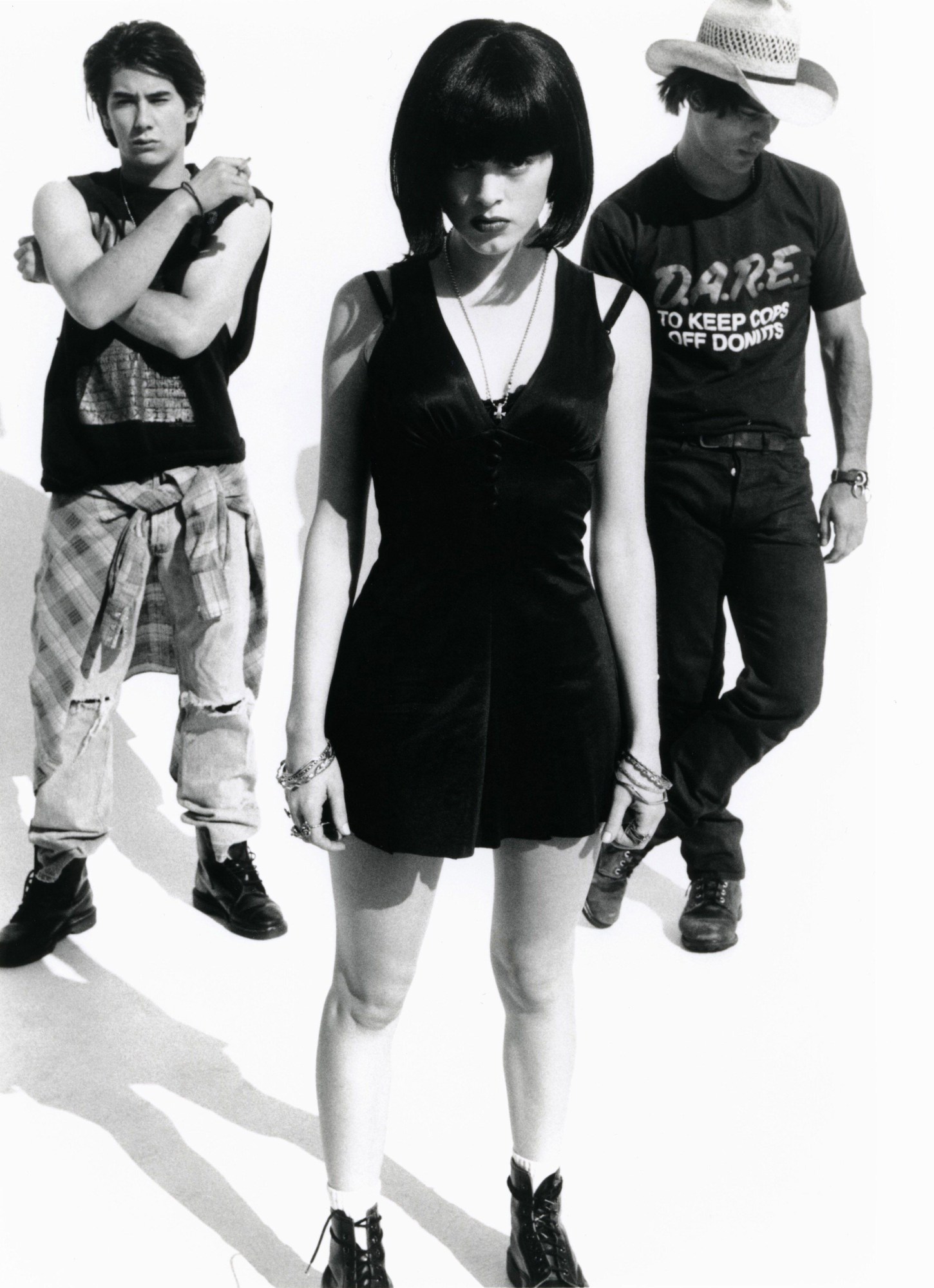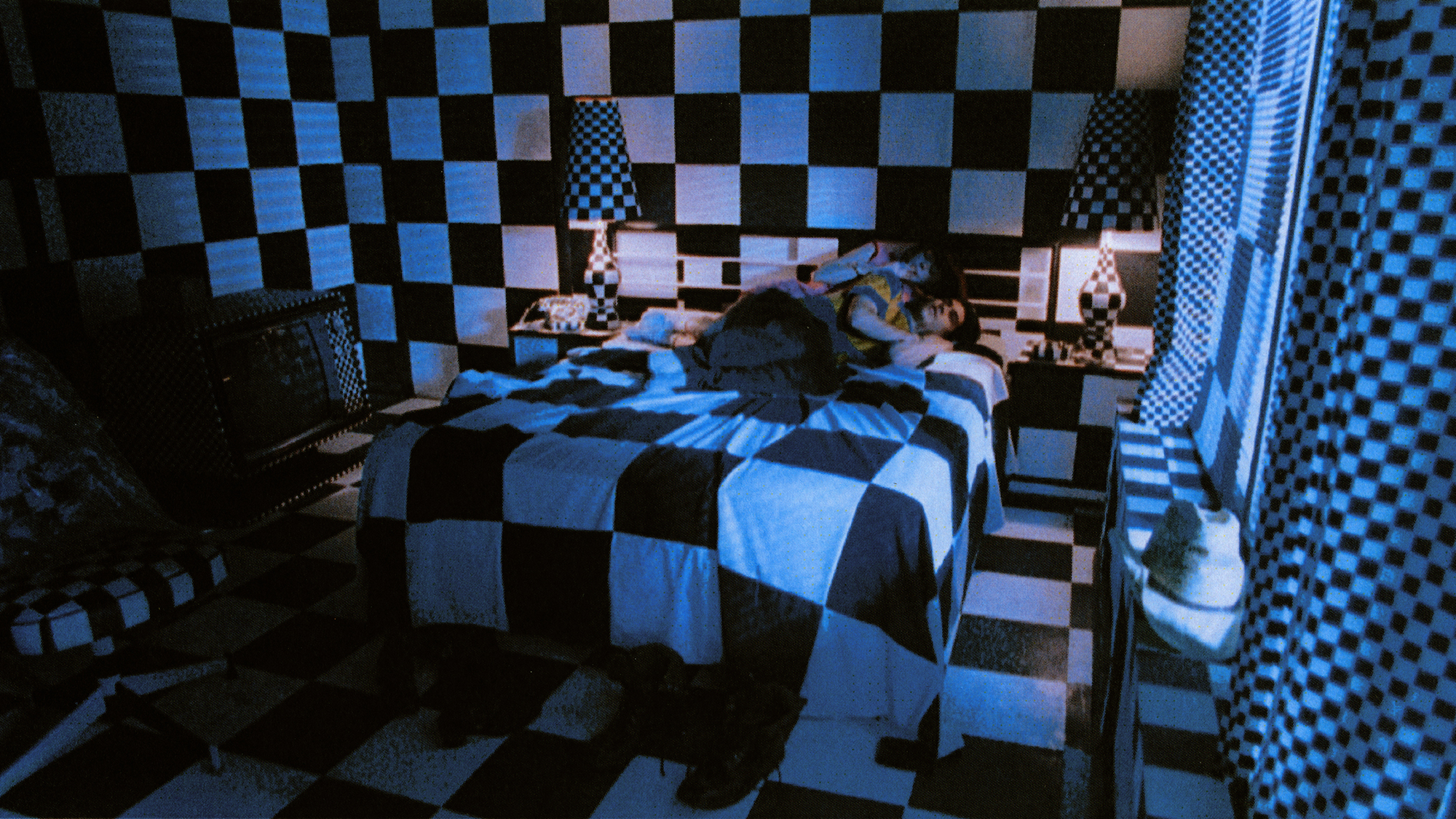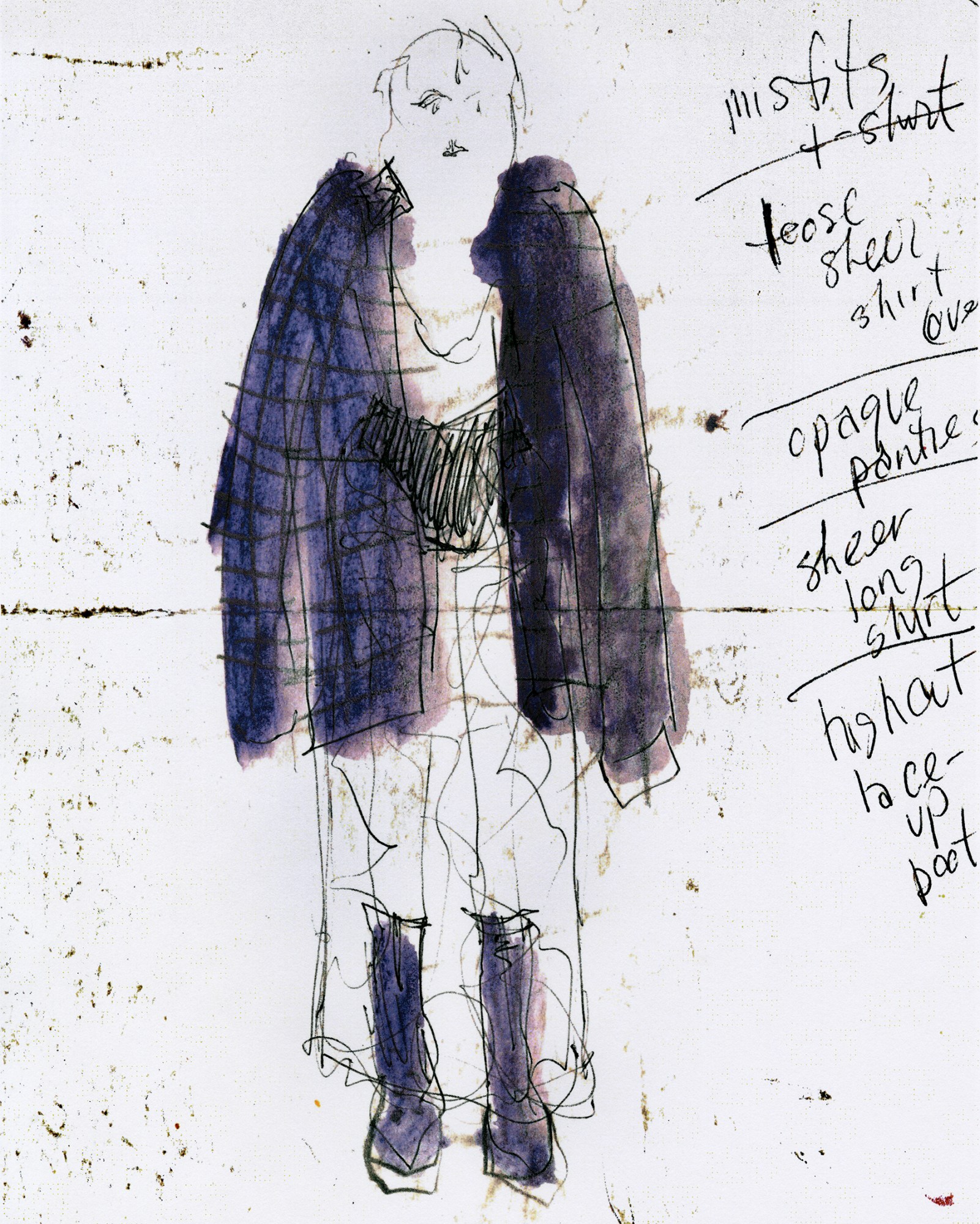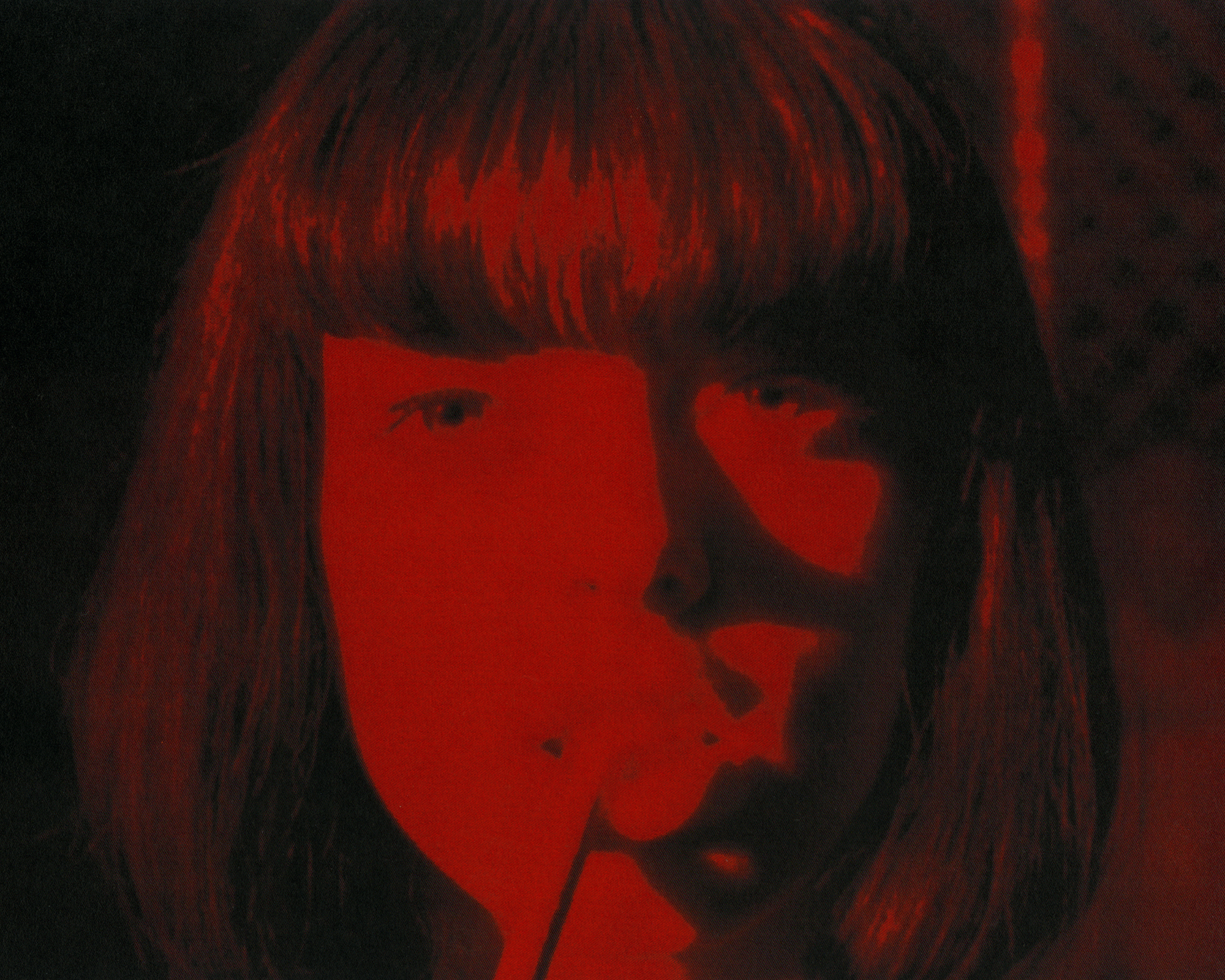After the first day of shooting The Doom Generation, Gregg Araki’s acid satire of LA slacker youth, a magnitude 6.7 earthquake struck the San Fernando Valley. Its reverberations reached as far away as Las Vegas, and while the 10 freeway collapsed in Culver City, the director hit the gas on his sex-and-murder road movie that would soon become the visual lingua franca for generations of alienated teens.
Set against a nocturnal hellscape of radioactive-orange fast food and hallucinogenic motel rooms, the film follows stoner Jordan White (James Duval) and his meth and Diet Coke-addled girlfriend Amy Blue (Rose McGowan, in her debut role) who pick up a sexy drifter known as X (Johnathon Schaech). After an accidental, camp-gore murder by decapitation in a 7-Eleven, they hit the road, embarking on a shoegaze-soundtracked spree of violence, threesomes and convenience store cigarette runs.
Araki enlisted Cathy Cooper, an artist and costume designer known for her work on music videos for The Cramps and Alice in Chains, to crystallise his subversive take on the perennial alt-teen uniform: leather jackets, band T-shirts and vintage Americana. Cooper combed through thrift stores and friends’ closets (even her ex-husband’s) for pieces that felt as second-skin to the characters as their instantly quotable dialogue, like Amy’s throwback gangster-moll lingerie and clear plastic raincoat, and X’s ironic D.A.R.E. graphic tee and army jacket.
Passed around on low-quality VHS rips before finding a wider audience on the internet, today a new generation of kids are styling themselves after Araki’s characters and lining up to see Rose’s Psychocandy-red lipstick on the big screen in newly remastered 4K. (They’re also DMing James Duval on Instagram.)
In the years since, Cooper has exhibited sculpture and designed looks for the LA Philharmonic Orchestra, among other dance performances. Araki, meanwhile, is now in pre-production on his next feature, I Want Your Sex, written with his Now Apocalypse collaborator Karley Sciortino and starring Olivia Wilde, Cooper Hoffman and Charli xcx. And this month, the Criterion Collection will finally release Araki’s Teen Apocalypse Trilogy, including the films that bookended Doom, Totally F***ed Up and a 4K restoration of Nowhere.
Here, the pair look back on their memories of making Doom, discuss what exactly deserves icon status in culture and the beauty of creating something out of nothing.
Start by telling us the story of how you met.
Cathy Cooper: It was by chance. My friend, the costume designer Marsha Perloff was approached to do Doom and she was not available. Then you and I met…
Gregg Araki: Had you done features before? Or was it your first feature?
Cathy: I did one, called Hold Me, Kiss Me, Thrill Me.
Gregg: I know you did a lot of music videos and stuff.
Cathy: Yeah, you know. But dude, I can do anything.
Gregg: Well, that’s what I mean. It was quite a job. The budget for Doom Generation was so low. I think it was $750,000 or something. All the departments really had to pull a rabbit out of the hat. The fact that there’s actually a movie is something of a miracle.

Cathy: To be resourceful is a good asset.
Gregg: That’s what was so exciting about it. Because the budget was so tight, you couldn’t just throw money at any problem. You had to be really creative. A lot of the stuff was from thrift stores. You were saying you got Parker Posey’s heart-shaped glasses at the 99-cent store. Where was the clear raincoat from? The infamous clear raincoat?
Cathy: I think I thrifted that one, too, at St. Vincent de Paul.
Gregg: Crazy stuff was just being pulled out of the hat. But you also sewed and had to alter stuff.
Did you have a strong perspective on how you wanted your three lead characters to look, Gregg?
Gregg: I had done my previous four movies all on my own. I shot them, production designed them, got the wardrobe, everything. To be able to collaborate with a cinematographer, a costume person and a production designer – it was a new world. Recently, I remember seeing a drawing I did of Amy. I had a very clear picture of [who she was]: five feet tall, this little thing with this Anna Karina bob haircut who wears a leather jacket, smokes cigarettes and says “fuck” all the time. The purse in that drawing was a Mickey Mouse head, but we obviously couldn’t licence Mickey Mouse. Instead, [production designer] Thérèse [DePrez] got that plastic globe thing. Cathy borrowed [Amy’s] leather jacket from Bill, the camera guy, right? It was such a cool look.
Cathy: Yeah.
Gregg: It was a weird police jacket, so it wasn’t the standard black leather jacket all the kids on Melrose were wearing. It was its own take on that. And Amy’s dress was your dress, right? You chopped it off because she was supposed to be wearing this little minidress. There was a lot of creating these iconic looks out of thin air.








Gregg, you said that the Ministry shirt James Duval was wearing was yours.
Gregg: I was so into those bands. I had a bunch of T-shirts, like the Ministry shirt, the Nitzer Ebb shirt, and that ‘I Blame Society’ shirt that Jimmy wears in Totally F***ed Up. That was mine. The second outfit that Jimmy changes into in Doom is actually [the director of photography] Jim Fealy’s outfit. He showed up on set wearing that blue and yellow striped shirt and baggy pants, and I thought, “That’s what I want Jimmy to wear for the second half of the movie.” And Cathy’s like, “Check! One less outfit for me to find…” [laughs] We literally took it off James’ back and put it on Jimmy. It was huge on Jimmy because Jim Fealy is so tall.
Cathy: But that sizing was perfect.
Gregg: The D.A.R.E. shirt that X wears, where did you find that Cathy? That wasn’t scripted.
Cathy: That was another one that I thrifted.
Gregg: You had an archive, too, of stuff from your music videos.
Cathy: Yeah. It was a lot of sourcing: [my] closet, individual people contributing stuff, thrifting stuff.
All those tiny details: the bowling ball bag that Amy carries; the D.A.R.E. T-shirt; “KILL” written on Amy’s knuckles…
Gregg: The “KISS” and the “KILL” [on Amy’s knuckles] was in the script. It’s pretty crazy, when you think about those looks and how iconic they were, that they were made with no money was pretty incredible.
Rose said she still has the black dress.
Gregg: What happened to the pink dress? That should be in a museum somewhere. The pink dress and the clear raincoat.
Cathy: Between Parker’s look and that, those are my two favourites.
The cameos in Doom are incredible. Why was Heidi Fleiss—
Gregg: One thing that Cathy didn’t have anything to do with was Heidi Fleiss’ crazy bathrobe…
Cathy: That was bonkers.
Gregg: [Heidi] was so famous at that time, when all that shit was going on. [Editor’s Note: Heidi, who ran a famous, upscale sex worker ring in Los Angeles, was in the middle of a legal battle when she made the film.] [Heidi’s rep was] all, “But the one condition is she’s selling bathrobes and she wants to wear one of them.” She’s behind the counter of the liquor store or whatever. It was so fucking hilarious.
Cathy: I love that that’s on her rider.
“I don’t think Doom would be as cool if it had a $10 million budget. It was like the world didn’t want us to do it.”
Gregg araki
Gregg: And then did we keep the robe? Because I saw stills of Rose wearing the robe off-camera to stay warm. Talk about fucking collectibles.
Have you seen many of the Doom looks out in the wild? With the [restorations] of Doom and Nowhere [screening across the US,] a lot of kids are getting back in the mix.
Gregg: I saw Jimmy [Duval] last night. Jimmy’s very active on social media. He gets pictures all the time from teenagers dressed up like The Doom Generation. There’s a really intense and passionate following for those movies. That’s the thing about punk rock and alternative culture: that look is how you find your tribe. They wear those clothes and watch those movies and listen to those bands. Obviously we took that look from that culture – we can’t claim ownership to the culture itself – but it is still alive and well.
Today, fashion designers will do big film collaborations. I think an iconic look in costume design doesn’t exclusively have to mean high concept ideas or an elaborate schematic. What do you think?
Gregg: Are you talking about branding and stuff? It hasn’t changed, really. I just do my thing and hope people like it. I’m of a different generation. I know I have a brand that I’ve created, but I don’t think about branding. For the box set, we spent so much time revisiting these movies. It really made me nostalgic. It was just so punk rock and wasn’t for the faint of heart. I don’t think Doom would be as cool if it had a $10 million budget. It was like the world didn’t want us to do it. There was the earthquake, and all these bad things kept happening on the set, but we pulled it off. It’s such a testament to the human spirit and creativity. Not letting lack of money, or whatever, stand in your way. Thérèse and Michael Krantz making that black-and-white check room by hand, literally painting ashtrays and tables and shit all night. It’s so much cooler than, “Oh yeah, they had 50 people do that in two hours.”
Cathy: The stuff that I think that I really respond to is beyond branding. Branding, it’s really tired. Because it’s people trying too hard to create something iconic. The things that truly are iconic are real… a direct expression of self. The people that really land with visual iconography are the people who are instilled in that thing. If we’re talking about costumes, I’ll tell you one of the things that I thought was really great. You know that series Wednesday? That costume design was beyond. That black dress? That’s somebody that knows their craft, that really understands modernism and classical design. That’s not something you can just manufacture. Artists make that stuff. Real, dedicated artists.
Writer: Colleen Kelsey
